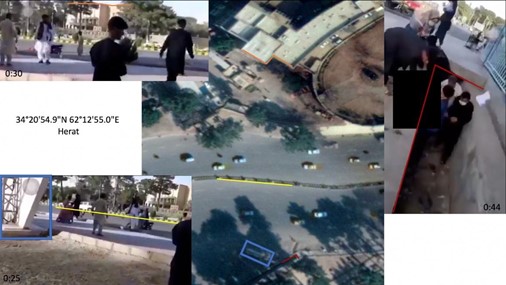Since the Taliban seized Afghanistan on August 15, female-led protests have been held in major cities across the country, including Kabul, Herat, Kandahar, Mazar-i-Sharif and Zaranj.
Footage from multiple cities shows groups of women protesting against the Taliban and demanding their right to equality, work, and education. On several occasions, anti-Taliban protests also displayed strong anti-Pakistan messaging.
The Afghan Witness (AW) database currently holds footage of at least 14 separate events and this is growing on a daily basis despite the ban on protests and slogans that have not been pre-approved by the Taliban.
 Map 1: Overview of cities where anti-Taliban protests have been observed since September
Map 1: Overview of cities where anti-Taliban protests have been observed since September
At some protests, footage has emerged showing the Taliban attempting to disrupt protesters, in some cases leading to violence:
On September 6, a Taliban vehicle attempted to disrupt a women’s protest in Mazar-i-Sharif by driving at protesters.
 Figure 1: Geolocation of protest in Mazar-i-Sharif
Figure 1: Geolocation of protest in Mazar-i-Sharif
On September 7, it was reported that two people were killed as the Taliban opened fire on a crowd after a peaceful protest in front of the Herat government office. According to online sources, many protesters also had their mobile phones confiscated.
 Figure 2: Geolocation of women fleeing shots during women-led protests in Herat.
Figure 2: Geolocation of women fleeing shots during women-led protests in Herat.  Figure 3: Geolocation of fatal shooting during women-led protests in Herat.
Figure 3: Geolocation of fatal shooting during women-led protests in Herat.
On September 7, footage emerged of Taliban fighters shooting bullets into the air in Kabul – an apparent attempt to disperse protesters demonstrating against the Taliban and Pakistan.
 Figure 4: Geolocation of incident during women protests in Kabul on September 7
Figure 4: Geolocation of incident during women protests in Kabul on September 7
On the same day, approximately 30 women were temporarily held in a car park in Kabul, reportedly to prevent them from joining the ongoing protest.
On September 8, a video emerged showing Taliban fighters [GRAPHIC] attacking protesting women in Kabul.
 Figure 5: Geolocation of incident during women’s protest in Kabul on September 8
Figure 5: Geolocation of incident during women’s protest in Kabul on September 8
On September 30, footage appeared of Taliban fighters harassing a woman and shooting bullets into the air in an apparent attempt to break up and disperse protesters in Kabul.
 Figure 6: Geolocation of incident during women’s protest in Kabul on September 30
Figure 6: Geolocation of incident during women’s protest in Kabul on September 30  Figure 7: Locations of all identified violent incidents during women-led protests in Kabul
Figure 7: Locations of all identified violent incidents during women-led protests in Kabul
Journalists attempting to cover the women’s rights protests have also faced disruption. According to The Committee to Protect Afghan Journalists, there have been numerous cases of violence against journalists since the Taliban takeover.
A video from a women’s protest in Balkh province on September 6 shows a Taliban fighter with a gun threatening journalists.
 Figure 8: Geolocation of harassment of journalists in Balkh
Figure 8: Geolocation of harassment of journalists in Balkh
On September 8, two journalists from the news agency Etilatrooz were reportedly arrested as they covered a women’s protest in Kabul. One of the journalists reported that they were taken to the Karte Chahar prison in PD3, where they were [GRAPHIC] violently beaten. Images of their injuries – which included large weals and bruises – were shared widely on social media.
Footage from October 21 shows an AFP journalist being violently attacked by Taliban fighters while covering a women’s protest in Kabul. The geolocation of the incident can be found in Figure 5.
Organisations have expressed concern over the future of press freedom under Taliban rule.
According to Human Rights Watch, in late September the Taliban Ministry of Information and Culture distributed strict media regulations that prohibited outlets from printing or broadcasting reports that “are contrary to Islam,” “insult national figures,” or “distort news content.”
The regulations stated that journalists are required to “ensure that their reporting is balanced” and not report on “matters that have not been confirmed by officials” or issues that “could have a negative impact on the public’s attitude.” They also stated that media outlets would be required to “prepare detailed reports” with the new governmental regulatory body prior to publication.
In the days following their takeover, Spokesperson Suhail Shaheen claimed the Taliban “believes in freedom of speech” and suggested those rights will extend to women in Afghanistan. However, the quasi-ban on protests, coupled with the regulations issued to the media, have raised concerns over the credibility of such claims.


